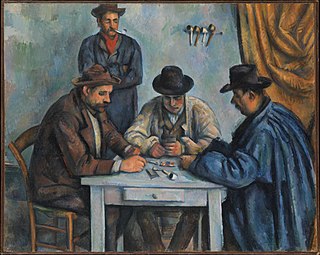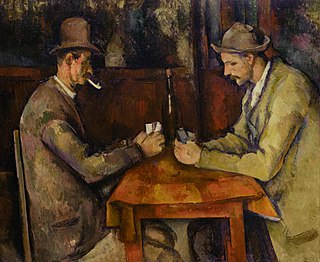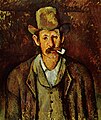The card players
| The card players |
|---|
| Paul Cezanne |

|
| New York Version , 1890-1892 |
| Oil on canvas, 65.4 cm × 81.9 cm |
| Metropolitan Museum of Art , New York |
|
|

|
| Philadelphia version , 1890-1892 |
| Oil on canvas, 134.6 cm × 180.3 cm |
| Barnes Foundation , Philadelphia |
|
|

|
| Privately owned version , 1892–1893 |
| Oil on canvas, 97 cm × 130 cm |
| Privately owned |
|
|

|
| London version , 1892–1895 |
| Oil on canvas, 60 cm × 73 cm |
| Courtauld Institute of Art , London |
|
|

|
| Paris version , 1894–1895 |
| Oil on canvas, 47 cm × 56.5 cm |
| Musée d'Orsay , Paris |
The Card Players (Les Joueurs de cartes) is the title of a series of paintings by the French painter Paul Cézanne . The pictures show men playing cards at a table. In the first half of the 1890s, five different-sized versions of the motif were created , which differ, among other things, in the number of people depicted.
Four of the paintings are exhibited in public museums. The fifth was privately owned by the Greek collector Georges Embiricos for years . It is said to have been sold shortly before or after his death. Several sources put the purchase price at various amounts between 250 and 275 million US dollars . This was the second highest purchase price that has been paid for an image to date (as of February 6, 2015).
description
The first version of the card player , exhibited today in the New York Metropolitan Museum of Art , shows three farm workers in an area of 65.4 by 81.9 centimeters who have grouped themselves around a table inside a house to play cards; Another man stands in the background, pipe smoking, and watching the game. The characters have expressionless faces and remain calm; the picture does not convey any movement and is reminiscent of a still life . The seated are bent over the light table, each of which occupies one side; the side of the table facing the viewer with a drawer remains free. On the table are played cards and a pipe. All men wear dark hats and jackets. The surroundings are ambiguous: in the background only a light wall can be seen with four more tobacco pipes hanging on it. A yellow curtain protrudes into the picture from the right. The left part of the actually white or light gray wall in particular is enriched with colors: green, blue and yellow tones suggest Provencal light falling through a door or window outside the visible section.
The second version, now in the collection of the Barnes Foundation in Philadelphia , is very similar to the one described above, but is significantly larger at 134.6 by 180.3 centimeters. The figures from the first picture and their arrangement have been taken over by Cézanne, with the exception of details. Only the hat of the man sitting opposite the viewer has disappeared. To the right behind this player, the painter has added another figure to the group: there is a dark-haired person of indefinite gender, a woman or a boy, with his eyes turned downwards or his eyes closed. The standing viewer has moved a little further into the background and seems to be leaning against the wall. Further details have been added in the upper half of the image. In the middle of the wall there is a painting with a gold frame, the lower part of which protrudes into the picture. In the upper left corner you can see the beginning of a shelf with a vase on it.
The last three versions differ significantly from their predecessors. They are so similar to one another that they are often taken together as one version. The artist concentrated the work here heavily on the card game, reduced the number of players to two, to the right and left of the table, and removed the audience and the details in the background, so that only the most essential part of the picture remains: two men immersed in the card game. The one on the left smokes a pipe and is dressed more formally with a cylinder- like brown hat with a downward-pointing brim. He is still sitting a little bent over, but more upright than the person opposite. The clothing of the right man is lighter and wider, his shorter hat has an upward brim. White shirt collars protrude from under both coats. There is nothing left on the table except a centrally placed, dark wine bottle that almost disappears into the background. The large bright areas of the earlier versions have also disappeared. The table is reddish-earthy, the background also darker. It's out of focus, but the wall looks closer to the players, leaving a smaller room. The color palette is determined by ocher, gray, brown and blue tones.
Probably the best-known example of these three is the smallest and probably the latest. It measures 47 by 56.5 centimeters and is part of the exhibition at the Musée d'Orsay in Paris . The art historian Meyer Schapiro described this picture as " the most monumental and also the most refined " (German: "the most monumental and most refined") picture of the card player series. The forms have become simpler here, the painting style more reserved. The colors come almost exclusively from the ocher area and give the picture a uniform, sepia- like effect. Even the playing cards, bright white in the other versions, lose their brightness due to the yellowish-gray admixture and fit into the palette. The composition of the picture completely dispenses with straight lines. The table top and legs are just as crooked as the wine bottle. Nevertheless, the picture does not trigger a feeling of seasickness in the viewer , since every oblique line is balanced out by another. Examples of this can be the oppositely curved hat brims or the jacket pockets that are aligned against the players' arms.
The other two versions are 97 by 130 centimeters and 60 by 73 centimeters. They are privately owned or at the Courtauld Institute of Art in London . All paintings in the series were created in oil on canvas .
Origin and classification in Cézanne's oeuvre
The 1880s and 1890s represented a period of synthesis and consolidation in Cézanne's oeuvre . The artist decidedly distanced himself from his earlier impressionist painting style and devoted himself to balanced compositions in which he increasingly used horizontal, vertical and diagonal lines to structure surfaces. During this period he increasingly created landscapes and figures.
For the card player series, Cézanne developed a remarkable series of draft drawings and preparatory work. In 1890 he started working on the final versions. The exact completion dates of the individual pictures are unknown. At the beginning of the 1890s he also made a series of portraits of smoking men who are seen in connection with the card players .
- Preparatory work and related works
Pipe Smoker (Study of Card Players) (1890–1892) Oil on canvas, 39 × 30.2 cm Nelson-Atkins Museum of Art
Study of the Card Players (1890–1892) Oil on canvas, 32 × 35 cm, Worcester Art Museum
Study of the Card Players (1890–1892) Graphite and watercolor on paper, Rhode Island School of Design Museum
Pipe smoker (around 1890) Oil on canvas, 90 × 72 cm, Hermitage
Pipe smoker (around 1892) oil on canvas, 73 × 60 cm, Courtauld Institute of Art
Man Smoking a Pipe (1890–1892) Oil on canvas, 72 × 91 cm, Pushkin Museum
Cézanne knew the men who appear in these pictures personally: They were workers on his family's estate in Aix-en-Provence .
While it was long believed that Cézanne had made the largest painting first and then chose smaller and smaller formats as the series progressed, X-ray and infrared images at the beginning of the 21st century showed graphite drawings under the visible surface of the Metropolitan version , some of which were very sketchy, and areas that were heavily worked with oil paint. It was concluded that Cézanne was trying to arrange the shapes here that can be seen in the larger version of the Barnes Collection.
The Card Players is one of the most important series of works by Cézanne from the early 1890s. At the same time, it bridges the gap between this phase and the last creative period of the artist. The first two versions of the motif still contain influences by Gustave Courbet , who influenced Cézanne's earlier work. The later three workpieces show a clear departure from this and are considered pioneers of Cubism . The art historian Richard Dorment summarizes:
"Cézanne's series of paintings The Card Players is the cornerstone of his work between 1890 and 1895, and the prelude to the explosive creative achievement of his last years."
"The Cézanne picture series The Card Players is the cornerstone of his work between 1890 and 1895 and the prelude to the explosive creative achievements of his last years."
Sales record
The painting, which is not on public display, was privately owned by the Greek tanker billionaire and art collector Georges Embiricos for decades . It was not open to the public and was not loaned for collective exhibitions for which the other card player versions were brought together. Georges Embiricos died in spring 2011. Around the same time, various newspapers, including the Financial Times and Die Welt , citing anonymous sources, reported that the painting had been sold. The purchase price was put at an indefinite size "between 250 and 275 million dollars " (about 170 to 190 million euros ). That would make it the most expensive painting to date. The record was previously from Jackson Pollock's No. 5, 1948, which had sold for $ 140 million in 2006.
Web links
- Paul Cézanne: The Card Players, Courtauld Gallery, review for the Courtauld Institute of Art in the Daily Telegraph, October 25, 2010
- Video guide to the paintings
The individual paintings in the online catalogs of their museums
- The Card Players , Metropolitan Museum of Art
- The Card Players , Barnes Foundation
- The Card Players , Courtauld Gallery
- The Card Players , Musée d'Orsay
Individual evidence
- ↑ a b c d e f g h i Richard Dorment: Paul Cézanne: The Card Players, Courtauld Gallery, review. In: Online edition of the Daily Telegraph . October 25, 2010, accessed August 21, 2011 .
- ↑ Collection catalog . In: Internet pages of the Musée d'Orsay . Retrieved August 21, 2011 .
- ^ A b c d Mary Tompkins Lewis: New Lessons on an Old Hand. In: Wall Street Journal online . February 9, 2011, accessed August 21, 2011 .
- ↑ The painting The smoker with propped arm ( Le fumeur accoudé ) from 1890 in the Kunsthalle Mannheim can be compared well in terms of style and color tone . ( Online )
- ↑ a b Stefan Koldehoff: The riddle of the most expensive painting in the world. In: Welt Online . July 31, 2011, accessed July 31, 2011 .
- ^ Georgina Adam: The Art Market: High stakes. In: Online edition of the Financial Times . March 11, 2011, accessed August 21, 2011 .





